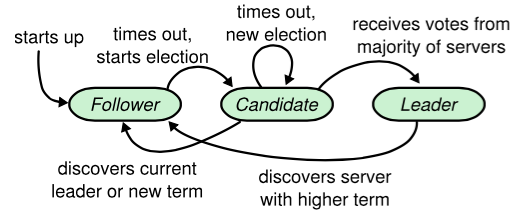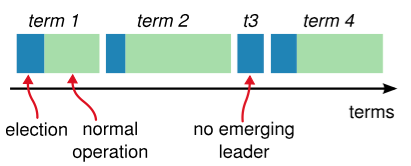Raft协议是用来解决分布式系统一致性问题的协议,在很长一段时间,Paxos被认为是解决分布式系统一致性的代名词。但是Paxos难于理解,更难以实现,诸如Google大牛们开发的分布式锁系统Chubby都遭遇了很多坑。Raft协议设计的初衷就是容易实现,保证对于普遍的人群都可以十分舒适容易的去理解。另外,它必须能够让人形成直观的认识,这样系统的构建者才能够在现实中进行必然的扩展。
本文从Redis Sentinel集群选择Leader的具体流程和源码分析,描述Raft协议中的选举Leader算法。关于Redis Sentinel的介绍可以参看本人的另一篇文章《redis sentinel设计与实现》。
当Sentinel集群有Sentinel发现master客观下线了,就会开始故障转移流程,故障转移流程的第一步就是在Sentinel集群选择一个Leader,让Leader完成故障转移流程。
Raft协议选举流程
描述Raft选举流程之前需要了解一些概念。
节点的状态
Raft协议描述的节点共有三种状态:Leader, Follower, Candidate。在系统运行正常的时候只有Leader和Follower两种状态的节点。一个Leader节点,其他的节点都是Follower。Candidate是系统运行不稳定时期的中间状态,当一个Follower对Leader的的心跳出现异常,就会转变成Candidate,Candidate会去竞选新的Leader,它会向其他节点发送竞选投票,如果大多数节点都投票给它,它就会替代原来的Leader,变成新的Leader,原来的Leader会降级成Follower。

term
在分布式系统中,各个节点的时间同步是一个很大的难题,但是为了识别过期时间,时间信息又必不可少。Raft协议为了解决这个问题,引入了term(任期)的概念。Raft协议将时间切分为一个个的Term,可以认为是一种“逻辑时间”。

RPC
Raft协议在选举阶段交互的RPC有两类:RequestVote和AppendEntries。
- RequestVote是用来向其他节点发送竞选投票。
- AppendEntries是当该节点得到更多的选票后,成为Leader,向其他节点确认消息。
选举流程
Raft采用心跳机制触发Leader选举。系统启动后,全部节点初始化为Follower,term为0.节点如果收到了RequestVote或者AppendEntries,就会保持自己的Follower身份。如果一段时间内没收到AppendEntries消息直到选举超时,说明在该节点的超时时间内还没发现Leader,Follower就会转换成Candidate,自己开始竞选Leader。一旦转化为Candidate,该节点立即开始下面几件事情:
- 1、增加自己的term。
- 2、启动一个新的定时器。
- 3、给自己投一票。
- 4、向所有其他节点发送RequestVote,并等待其他节点的回复。
如果在这过程中收到了其他节点发送的AppendEntries,就说明已经有Leader产生,自己就转换成Follower,选举结束。
如果在计时器超时前,节点收到多数节点的同意投票,就转换成Leader。同时向所有其他节点发送AppendEntries,告知自己成为了Leader。
每个节点在一个term内只能投一票,采取先到先得的策略,Candidate前面说到已经投给了自己,Follower会投给第一个收到RequestVote的节点。每个Follower有一个计时器,在计时器超时时仍然没有接受到来自Leader的心跳RPC, 则自己转换为Candidate, 开始请求投票,就是上面的的竞选Leader步骤。
如果多个Candidate发起投票,每个Candidate都没拿到多数的投票(Split Vote),那么就会等到计时器超时后重新成为Candidate,重复前面竞选Leader步骤。
Raft协议的定时器采取随机超时时间,这是选举Leader的关键。每个节点定时器的超时时间随机设置,随机选取配置时间的1倍到2倍之间。由于随机配置,所以各个Follower同时转成Candidate的时间一般不一样,在同一个term内,先转为Candidate的节点会先发起投票,从而获得多数票。多个节点同时转换为Candidate的可能性很小。即使几个Candidate同时发起投票,在该term内有几个节点获得一样高的票数,只是这个term无法选出Leader。由于各个节点定时器的超时时间随机生成,那么最先进入下一个term的节点,将更有机会成为Leader。连续多次发生在一个term内节点获得一样高票数在理论上几率很小,实际上可以认为完全不可能发生。一般1-2个term类,Leader就会被选出来。
Sentinel的选举流程
Sentinel集群正常运行的时候每个节点epoch相同,当需要故障转移的时候会在集群中选出Leader执行故障转移操作。Sentinel采用了Raft协议实现了Sentinel间选举Leader的算法,不过也不完全跟论文描述的步骤一致。Sentinel集群运行过程中故障转移完成,所有Sentinel又会恢复平等。Leader仅仅是故障转移操作出现的角色。
选举流程
- 1、某个Sentinel认定master客观下线的节点后,该Sentinel会先看看自己有没有投过票,如果自己已经投过票给其他Sentinel了,在2倍故障转移的超时时间自己就不会成为Leader。相当于它是一个Follower。
- 2、如果该Sentinel还没投过票,那么它就成为Candidate。
- 3、和Raft协议描述的一样,成为Candidate,Sentinel需要完成几件事情
- 1)更新故障转移状态为start
- 2)当前epoch加1,相当于进入一个新term,在Sentinel中epoch就是Raft协议中的term。
- 3)更新自己的超时时间为当前时间随机加上一段时间,随机时间为1s内的随机毫秒数。
- 4)向其他节点发送
is-master-down-by-addr命令请求投票。命令会带上自己的epoch。 - 5)给自己投一票,在Sentinel中,投票的方式是把自己master结构体里的leader和leader_epoch改成投给的Sentinel和它的epoch。
- 4、其他Sentinel会收到Candidate的
is-master-down-by-addr命令。如果Sentinel当前epoch和Candidate传给他的epoch一样,说明他已经把自己master结构体里的leader和leader_epoch改成其他Candidate,相当于把票投给了其他Candidate。投过票给别的Sentinel后,在当前epoch内自己就只能成为Follower。 - 5、Candidate会不断的统计自己的票数,直到他发现认同他成为Leader的票数超过一半而且超过它配置的quorum(quorum可以参考《redis sentinel设计与实现》)。Sentinel比Raft协议增加了quorum,这样一个Sentinel能否当选Leader还取决于它配置的quorum。
- 6、如果在一个选举时间内,Candidate没有获得超过一半且超过它配置的quorum的票数,自己的这次选举就失败了。
- 7、如果在一个epoch内,没有一个Candidate获得更多的票数。那么等待超过2倍故障转移的超时时间后,Candidate增加epoch重新投票。
- 8、如果某个Candidate获得超过一半且超过它配置的quorum的票数,那么它就成为了Leader。
- 9、与Raft协议不同,Leader并不会把自己成为Leader的消息发给其他Sentinel。其他Sentinel等待Leader从slave选出master后,检测到新的master正常工作后,就会去掉客观下线的标识,从而不需要进入故障转移流程。
关于Sentinel超时时间的说明
Sentinel超时机制有几个超时概念。
- failover_start_time 下一选举启动的时间。默认是当前时间加上1s内的随机毫秒数
- failover_state_change_time 故障转移中状态变更的时间。
- failover_timeout 故障转移超时时间。默认是3分钟。
- election_timeout 选举超时时间,是默认选举超时时间和failover_timeout的最小值。默认是10s。
Follower成为Candidate后,会更新failover_start_time为当前时间加上1s内的随机毫秒数。更新failover_state_change_time为当前时间。
Candidate的当前时间减去failover_start_time大于election_timeout,说明Candidate还没获得足够的选票,此次epoch的选举已经超时,那么转变成Follower。需要等到mstime() - failover_start_time < failover_timeout*2的时候才开始下一次获得成为Candidate的机会。
如果一个Follower把某个Candidate设为自己认为的Leader,那么它的failover_start_time会设置为当前时间加上1s内的随机毫秒数。这样它就进入了上面说的需要等到mstime() - failover_start_time < failover_timeout*2的时候才开始下一次获得成为Candidate的机会。
因为每个Sentinel判断节点客观下线的时间不是同时开始的,一般都有先后,这样先开始的Sentinel就更有机会赢得更多选票,另外failover_state_change_time为1s内的随机毫秒数,这样也把各个节点的超时时间分散开来。本人尝试过很多次,Sentinel间的Leader选举过程基本上一个epoch内就完成了。
Sentinel 选举流程源码解析
Sentinel的选举流程的代码基本都在sentinel.c文件中,下面结合源码对Sentinel的选举流程进行说明。
定时任务
void sentinelHandleRedisInstance(sentinelRedisInstance *ri) {
...
// 判断 master 是否进入SDOWN 状态
sentinelCheckSubjectivelyDown(ri);
/* Masters and slaves */
if (ri->flags & (SRI_MASTER|SRI_SLAVE)) {
/* Nothing so far. */
}
if (ri->flags & SRI_MASTER) {
// 判断 master 是否进入 ODOWN 状态
sentinelCheckObjectivelyDown(ri);
// 查看是否需要开始故障转移
if (sentinelStartFailoverIfNeeded(ri))
// 向其他 Sentinel 发送 SENTINEL is-master-down-by-addr 命令
// 刷新其他 Sentinel 关于主服务器的状态
sentinelAskMasterStateToOtherSentinels(ri,SENTINEL_ASK_FORCED);
// 执行故障转移
sentinelFailoverStateMachine(ri);
//此处调用sentinelAskMasterStateToOtherSentinels,只是为了获取其他Sentinel对于master是否存活的判断,
//用来下一次判断master是否进入ODOWN状态
sentinelAskMasterStateToOtherSentinels(ri,SENTINEL_NO_FLAGS);
}
}
Sentinel会每隔100ms执行一次sentinelHandleRedisInstance函数。流程会检查master是否进入SDOWN状态,接着会检查master是否进入ODOWN状态,接着会查看是否需要开始故障转移,如果开始故障转移就会向其他节点拉去投票,接下来有个故障转移的状态机,根据不同的failover_state,决定完成不同的操作,正常的时候failover_state为SENTINEL_FAILOVER_STATE_NONE。
向其他Sentinel获取投票或者获取对master存活状态的判断结果
#define SENTINEL_ASK_FORCED (1<<0)
void sentinelAskMasterStateToOtherSentinels(sentinelRedisInstance *master, int flags) {
dictIterator *di;
dictEntry *de;
// 遍历正在监视相同 master 的所有 sentinel
// 向它们发送 SENTINEL is-master-down-by-addr 命令
di = dictGetIterator(master->sentinels);
while((de = dictNext(di)) != NULL) {
sentinelRedisInstance *ri = dictGetVal(de);
// 距离该 sentinel 最后一次回复 SENTINEL master-down-by-addr 命令已经过了多久
mstime_t elapsed = mstime() - ri->last_master_down_reply_time;
char port[32];
int retval;
/* If the master state from other sentinel is too old, we clear it. */
// 如果目标 Sentinel 关于主服务器的信息已经太久没更新,那么我们清除它
if (elapsed > SENTINEL_ASK_PERIOD*5) {
ri->flags &= ~SRI_MASTER_DOWN;
sdsfree(ri->leader);
ri->leader = NULL;
}
/* Only ask if master is down to other sentinels if:
*
* 只在以下情况满足时,才向其他 sentinel 询问主服务器是否已下线
*
* 1) We believe it is down, or there is a failover in progress.
* 本 sentinel 相信服务器已经下线,或者针对该主服务器的故障转移操作正在执行
* 2) Sentinel is connected.
* 目标 Sentinel 与本 Sentinel 已连接
* 3) We did not received the info within SENTINEL_ASK_PERIOD ms.
* 当前 Sentinel 在 SENTINEL_ASK_PERIOD 毫秒内没有获得过目标 Sentinel 发来的信息
* 4) 条件 1 和条件 2 满足而条件 3 不满足,但是 flags 参数给定了 SENTINEL_ASK_FORCED 标识
*/
if ((master->flags & SRI_S_DOWN) == 0) continue;
if (ri->flags & SRI_DISCONNECTED) continue;
if (!(flags & SENTINEL_ASK_FORCED) &&
mstime() - ri->last_master_down_reply_time < SENTINEL_ASK_PERIOD)
continue;
/* Ask */
// 发送 SENTINEL is-master-down-by-addr 命令
ll2string(port,sizeof(port),master->addr->port);
retval = redisAsyncCommand(ri->cc,
sentinelReceiveIsMasterDownReply, NULL,
"SENTINEL is-master-down-by-addr %s %s %llu %s",
master->addr->ip, port,
sentinel.current_epoch,
// 如果本 Sentinel 已经检测到 master 进入 ODOWN
// 并且要开始一次故障转移,那么向其他 Sentinel 发送自己的运行 ID
// 让对方将给自己投一票(如果对方在这个纪元内还没有投票的话)
(master->failover_state > SENTINEL_FAILOVER_STATE_NONE) ?
server.runid : "*");
if (retval == REDIS_OK) ri->pending_commands++;
}
dictReleaseIterator(di);
}
对于每个节点,Sentinel都会确认节点是否SDOWN,对于master,还需要确认ODOWN。sentinelAskMasterStateToOtherSentinels方法会在master进入SDOWN或者ODOWN调用sentinel is-master-down-by-addr命令,SDOWN时,该命令用来获取其他Sentinel对于master的存活状态,ODOWN是用来像其他节点投票的。SDOWN时,flags是SENTINEL_NO_FLAGS,ODOWN时,flags是SENTINEL_ASK_FORCED。
检查是否开始故障转移
/* This function checks if there are the conditions to start the failover,
* that is:
*
* 这个函数检查是否需要开始一次故障转移操作:
*
* 1) Master must be in ODOWN condition.
* 主服务器已经计入 ODOWN 状态。
* 2) No failover already in progress.
* 当前没有针对同一主服务器的故障转移操作在执行。
* 3) No failover already attempted recently.
* 最近时间内,这个主服务器没有尝试过执行故障转移
* (应该是为了防止频繁执行)。
*
* We still don't know if we'll win the election so it is possible that we
* start the failover but that we'll not be able to act.
*
* 虽然 Sentinel 可以发起一次故障转移,但因为故障转移操作是由领头 Sentinel 执行的,
* 所以发起故障转移的 Sentinel 不一定就是执行故障转移的 Sentinel 。
*
* Return non-zero if a failover was started.
*
* 如果故障转移操作成功开始,那么函数返回非 0 值。
*/
int sentinelStartFailoverIfNeeded(sentinelRedisInstance *master) {
/* We can't failover if the master is not in O_DOWN state. */
if (!(master->flags & SRI_O_DOWN)) return 0;
/* Failover already in progress? */
if (master->flags & SRI_FAILOVER_IN_PROGRESS) return 0;
/* Last failover attempt started too little time ago? */
if (mstime() - master->failover_start_time <
master->failover_timeout*2)
{
if (master->failover_delay_logged != master->failover_start_time) {
time_t clock = (master->failover_start_time +
master->failover_timeout*2) / 1000;
char ctimebuf[26];
ctime_r(&clock,ctimebuf);
ctimebuf[24] = '\0'; /* Remove newline. */
master->failover_delay_logged = master->failover_start_time;
redisLog(REDIS_WARNING,
"Next failover delay: I will not start a failover before %s",
ctimebuf);
}
return 0;
}
sentinelStartFailover(master);
return 1;
}
sentinelStartFailoverIfNeeded方法会检查master是否为ODOWN状态。因为定时任务每次就会执行到该函数,所以还要确认故障转移状态SRI_FAILOVER_IN_PROGRESS是否已经开始。然后会看定时任务是否超时,只有以上条件都满足才能开始故障转移。关于定时任务是否超时,failover_start_time默认为0,它有2个地方会被修改,一个是开始故障转移后,一个是收到其他Sentinel的投票请求。failover_start_time被修改的值为
mstime()+rand()%SENTINEL_MAX_DESYNC,这就是Raft协议说的随机因子。SENTINEL_MAX_DESYNC是1000,相当于failover_start_time是当前时间加上1s内的随机值,这个保证了,不同Sentinel在超时后,下次申请Leader时间的随机。所以故障转移开始,像Raft协议描述的“启动一个新的定时器”,设置了failover_start_time。在投票的时候设置failover_start_time,那么先投票,再通过ODOWN和SRI_FAILOVER_IN_PROGRESS的节点,在检查定时任务是否超时的时候就无法通过,相当于是Raft协议中的Follower,它不会参与竞争Leader。
成为Candidate,开始竞选Leader
/* Setup the master state to start a failover. */
// 设置主服务器的状态,开始一次故障转移
void sentinelStartFailover(sentinelRedisInstance *master) {
redisAssert(master->flags & SRI_MASTER);
// 更新故障转移状态
master->failover_state = SENTINEL_FAILOVER_STATE_WAIT_START;
// 更新主服务器状态
master->flags |= SRI_FAILOVER_IN_PROGRESS;
// 更新纪元
master->failover_epoch = ++sentinel.current_epoch;
sentinelEvent(REDIS_WARNING,"+new-epoch",master,"%llu",
(unsigned long long) sentinel.current_epoch);
sentinelEvent(REDIS_WARNING,"+try-failover",master,"%@");
// 记录故障转移状态的变更时间
master->failover_start_time = mstime()+rand()%SENTINEL_MAX_DESYNC;
master->failover_state_change_time = mstime();
}
如果Sentinel通过三重检查,进入了sentinelStartFailover,相当于成为了Candidate,它会做以下几件事情:
- 1、把failover_state改成SENTINEL_FAILOVER_STATE_WAIT_START。
- 2、把master的状态改成故障转移中SRI_FAILOVER_IN_PROGRESS。
- 3、增加master的current_epoch,并赋值给failover_epoch。
- 4、把failover_start_time改成mstime()+rand()%SENTINEL_MAX_DESYNC。
- 5、把failover_state_change_time改成mstime()。
sentinelStartFailover完成了成为Candidate的前面两步,接着要回到前面的定时任务sentinelHandleRedisInstance。因为sentinelStartFailoverIfNeeded返回了1,所以进入if流程,执行sentinelAskMasterStateToOtherSentinels(ri,SENTINEL_ASK_FORCED);,开始向其他Sentinel拉票。然后就进入sentinelFailoverStateMachine。
Follower投票
这里先来看下投票的源码。
/* Vote for the sentinel with 'req_runid' or return the old vote if already
* voted for the specifed 'req_epoch' or one greater.
*
* 为运行 ID 为 req_runid 的 Sentinel 投上一票,有两种额外情况可能出现:
* 1) 如果 Sentinel 在 req_epoch 纪元已经投过票了,那么返回之前投的票。
* 2) 如果 Sentinel 已经为大于 req_epoch 的纪元投过票了,那么返回更大纪元的投票。
*
* If a vote is not available returns NULL, otherwise return the Sentinel
* runid and populate the leader_epoch with the epoch of the vote.
*
* 如果投票暂时不可用,那么返回 NULL 。
* 否则返回 Sentinel 的运行 ID ,并将被投票的纪元保存到 leader_epoch 指针的值里面。
*/
char *sentinelVoteLeader(sentinelRedisInstance *master, uint64_t req_epoch, char *req_runid, uint64_t *leader_epoch) {
if (req_epoch > sentinel.current_epoch) {
sentinel.current_epoch = req_epoch;
sentinelFlushConfig();
sentinelEvent(REDIS_WARNING,"+new-epoch",master,"%llu",
(unsigned long long) sentinel.current_epoch);
}
if (master->leader_epoch < req_epoch && sentinel.current_epoch <= req_epoch)
{
sdsfree(master->leader);
master->leader = sdsnew(req_runid);
master->leader_epoch = sentinel.current_epoch;
sentinelFlushConfig();
sentinelEvent(REDIS_WARNING,"+vote-for-leader",master,"%s %llu",
master->leader, (unsigned long long) master->leader_epoch);
/* If we did not voted for ourselves, set the master failover start
* time to now, in order to force a delay before we can start a
* failover for the same master. */
if (strcasecmp(master->leader,server.runid))
master->failover_start_time = mstime()+rand()%SENTINEL_MAX_DESYNC;
}
*leader_epoch = master->leader_epoch;
return master->leader ? sdsnew(master->leader) : NULL;
}
前面说到Candidate开始竞选后,会把当前epoch加1,这样就比Follower大1,Follower收到第一个Candidate的投票后,因为自己当前的epoch比Candidate小,所以把当前的epoch改成第一个Candidate的epoch,然后把自己认为的Leader设置成该Candidate。然后其他Candidate再发起对该Follower的投票时,由于这些Candidate的epoch与自己选出Leader的epoch一样,所以不会再改变自己认为的Leader。这样,在一个epoch内,Follower就只能投出一票,给它第一个收到投票请求的Candidate。最后有个if (strcasecmp(master->leader,server.runid)),这个是为了设置failover_start_time,这样Follower在当前epoch内,就无法成为Candidate了。
Sentinel执行任务的状态机
void sentinelFailoverStateMachine(sentinelRedisInstance *ri) {
redisAssert(ri->flags & SRI_MASTER);
if (!(ri->flags & SRI_FAILOVER_IN_PROGRESS)) return;
switch(ri->failover_state) {
case SENTINEL_FAILOVER_STATE_WAIT_START:
// 统计选票,查看是否成为leader
sentinelFailoverWaitStart(ri);
break;
case SENTINEL_FAILOVER_STATE_SELECT_SLAVE:
// 从slave列表中选出最佳slave
sentinelFailoverSelectSlave(ri);
break;
case SENTINEL_FAILOVER_STATE_SEND_SLAVEOF_NOONE:
// 把选出的slave设置为master
sentinelFailoverSendSlaveOfNoOne(ri);
break;
case SENTINEL_FAILOVER_STATE_WAIT_PROMOTION:
// 等待升级生效,如果升级超时,那么重新选择新主服务器
sentinelFailoverWaitPromotion(ri);
break;
case SENTINEL_FAILOVER_STATE_RECONF_SLAVES:
// 向从服务器发送 SLAVEOF 命令,让它们同步新主服务器
sentinelFailoverReconfNextSlave(ri);
break;
}
}
Sentinel处理故障转移流程是采用状态处理的模式,不同状态处理不同任务,任务完成后更新状态到下一个状态。sentinelFailoverStateMachine函数根据failover_state决定进入什么流程。在sentinelFailoverWaitStart函数里面,Leader就被选出了,其他几个状态是Leader进行故障转移的流程。
确认自己是否成为Leader
void sentinelFailoverWaitStart(sentinelRedisInstance *ri) {
char *leader;
int isleader;
/* Check if we are the leader for the failover epoch. */
// 获取给定纪元的领头 Sentinel
leader = sentinelGetLeader(ri, ri->failover_epoch);
// 本 Sentinel 是否为领头 Sentinel ?
isleader = leader && strcasecmp(leader,server.runid) == 0;
sdsfree(leader);
/* If I'm not the leader, and it is not a forced failover via
* SENTINEL FAILOVER, then I can't continue with the failover. */
// 如果本 Sentinel 不是领头,并且这次故障迁移不是一次强制故障迁移操作
// 那么本 Sentinel 不做动作
if (!isleader && !(ri->flags & SRI_FORCE_FAILOVER)) {
int election_timeout = SENTINEL_ELECTION_TIMEOUT;
/* The election timeout is the MIN between SENTINEL_ELECTION_TIMEOUT
* and the configured failover timeout. */
// 当选的时长(类似于任期)是 SENTINEL_ELECTION_TIMEOUT
// 和 Sentinel 设置的故障迁移时长之间的较小那个值
if (election_timeout > ri->failover_timeout)
election_timeout = ri->failover_timeout;
/* Abort the failover if I'm not the leader after some time. */
// Sentinel 的当选时间已过,取消故障转移计划
if (mstime() - ri->failover_start_time > election_timeout) {
sentinelEvent(REDIS_WARNING,"-failover-abort-not-elected",ri,"%@");
// 取消故障转移
sentinelAbortFailover(ri);
}
return;
}
// 本 Sentinel 作为领头,开始执行故障迁移操作...
sentinelEvent(REDIS_WARNING,"+elected-leader",ri,"%@");
// 进入选择从服务器状态
ri->failover_state = SENTINEL_FAILOVER_STATE_SELECT_SLAVE;
ri->failover_state_change_time = mstime();
sentinelEvent(REDIS_WARNING,"+failover-state-select-slave",ri,"%@");
}
前面说到的sentinelStartFailover把failover_state设置成SENTINEL_FAILOVER_STATE_WAIT_START,于是进入sentinelFailoverWaitStart。
sentinelFailoverWaitStart会先查看leader是否已经选出。如果Leader是自己或者这是一次强制故障转移,failover_state就设置为SENTINEL_FAILOVER_STATE_SELECT_SLAVE。强制故障转移是通过Sentinel的SENTINEL FAILOVER <master-name>命令设置的,这里不做讨论。
如果自己当选Leader,就会进入下一个任务处理状态,开始故障转移流程。如果在election_timeout内还没当选为Leader,那么本次epoch内,Candidate就没有当选,需要等待failover_timeout超时,进入下一次竞选,或者本次epoch内,有Leader被选出,自己变会Follower。
统计投票
/* Scan all the Sentinels attached to this master to check if there
* is a leader for the specified epoch.
*
* 扫描所有监视 master 的 Sentinels ,查看是否有 Sentinels 是这个纪元的领头。
*
* To be a leader for a given epoch, we should have the majorify of
* the Sentinels we know that reported the same instance as
* leader for the same epoch.
*
* 要让一个 Sentinel 成为本纪元的领头,
* 这个 Sentinel 必须让大多数其他 Sentinel 承认它是该纪元的领头才行。
*/
// 选举出 master 在指定 epoch 上的领头
char *sentinelGetLeader(sentinelRedisInstance *master, uint64_t epoch) {
dict *counters;
dictIterator *di;
dictEntry *de;
unsigned int voters = 0, voters_quorum;
char *myvote;
char *winner = NULL;
uint64_t leader_epoch;
uint64_t max_votes = 0;
redisAssert(master->flags & (SRI_O_DOWN|SRI_FAILOVER_IN_PROGRESS));
// 统计器
counters = dictCreate(&leaderVotesDictType,NULL);
/* Count other sentinels votes */
// 统计其他 sentinel 的主观 leader 投票
di = dictGetIterator(master->sentinels);
while((de = dictNext(di)) != NULL) {
sentinelRedisInstance *ri = dictGetVal(de);
// 为目标 Sentinel 选出的领头 Sentinel 增加一票
if (ri->leader != NULL && ri->leader_epoch == sentinel.current_epoch)
sentinelLeaderIncr(counters,ri->leader);
// 统计投票数量
voters++;
}
dictReleaseIterator(di);
/* Check what's the winner. For the winner to win, it needs two conditions:
*
* 选出领头 leader ,它必须满足以下两个条件:
*
* 1) Absolute majority between voters (50% + 1).
* 有多于一般的 Sentinel 支持
* 2) And anyway at least master->quorum votes.
* 投票数至少要有 master->quorum 那么多
*/
di = dictGetIterator(counters);
while((de = dictNext(di)) != NULL) {
// 取出票数
uint64_t votes = dictGetUnsignedIntegerVal(de);
// 选出票数最大的人
if (votes > max_votes) {
max_votes = votes;
winner = dictGetKey(de);
}
}
dictReleaseIterator(di);
/* Count this Sentinel vote:
* if this Sentinel did not voted yet, either vote for the most
* common voted sentinel, or for itself if no vote exists at all. */
// 本 Sentinel 进行投票
// 如果 Sentinel 之前还没有进行投票,那么有两种选择:
// 1)如果选出了 winner (最多票数支持的 Sentinel ),那么这个 Sentinel 也投 winner 一票
// 2)如果没有选出 winner ,那么 Sentinel 投自己一票
if (winner)
myvote = sentinelVoteLeader(master,epoch,winner,&leader_epoch);
else
myvote = sentinelVoteLeader(master,epoch,server.runid,&leader_epoch);
// 领头 Sentinel 已选出,并且领头的纪元和给定的纪元一样
if (myvote && leader_epoch == epoch) {
// 为领头 Sentinel 增加一票(这一票来自本 Sentinel )
uint64_t votes = sentinelLeaderIncr(counters,myvote);
// 如果投票之后的票数比最大票数要大,那么更换领头 Sentinel
if (votes > max_votes) {
max_votes = votes;
winner = myvote;
}
}
voters++; /* Anyway, count me as one of the voters. */
// 如果支持领头的投票数量不超过半数
// 并且支持票数不超过 master 配置指定的投票数量
// 那么这次领头选举无效
voters_quorum = voters/2+1;
if (winner && (max_votes < voters_quorum || max_votes < master->quorum))
winner = NULL;
// 返回领头 Sentinel ,或者 NULL
winner = winner ? sdsnew(winner) : NULL;
sdsfree(myvote);
dictRelease(counters);
return winner;
}
sentinelGetLeader会统计所有其他Sentinel的投票结果,如果投票结果中有个Sentinel获得了超过半数且超过master的quorum,那么Leader就被选出了。
Candidate第一次进入sentinelGetLeader函数的时候是还没向其他Sentinel发起投票,winner为NULL,于是就会给自己投上一票,这就是前面Raft协议说到的,在开始竞选前“3、给自己投一票“,这样竞选前的4个步骤就全部完成了。以后再进入sentinelGetLeader就可以统计其他Sentinel的投票数目。当发现有个Sentinel的投票数据超过半数且超过quorum,就会返回该Sentinel,sentinelFailoverWaitStart会判断该Sentinel是否是自己,如果是自己,那么自己就成为了Leader,开始进行故障转移,不是自己,那么等待竞选超时,成为Follower。
关于Leader通知其他Sentinel自己成为Leader的说明
在Sentinel的实现里面。关于Leader发送竞选成功的消息给其他Sentinel,并没有专门的逻辑。某个Sentinel成为Leader后,他就默默的干起活。故障转移中Leader通过获取选出的slave的INFO信息,发现其确认了master身份,Leader就会修改config_epoch为最新的epoch。
/* Process the INFO output from masters. */
void sentinelRefreshInstanceInfo(sentinelRedisInstance *ri, const char *info) {
...
/* Handle slave -> master role switch. */
// 处理从服务器转变为主服务器的情况
if ((ri->flags & SRI_SLAVE) && role == SRI_MASTER) {
/* If this is a promoted slave we can change state to the
* failover state machine. */
if ((ri->master->flags & SRI_FAILOVER_IN_PROGRESS) &&
(ri->master->failover_state ==
SENTINEL_FAILOVER_STATE_WAIT_PROMOTION))
{
/* Now that we are sure the slave was reconfigured as a master
* set the master configuration epoch to the epoch we won the
* election to perform this failover. This will force the other
* Sentinels to update their config (assuming there is not
* a newer one already available). */
ri->master->config_epoch = ri->master->failover_epoch;
ri->master->failover_state = SENTINEL_FAILOVER_STATE_RECONF_SLAVES;
ri->master->failover_state_change_time = mstime();
sentinelFlushConfig();
sentinelEvent(REDIS_WARNING,"+promoted-slave",ri,"%@");
sentinelEvent(REDIS_WARNING,"+failover-state-reconf-slaves",
ri->master,"%@");
sentinelCallClientReconfScript(ri->master,SENTINEL_LEADER,
"start",ri->master->addr,ri->addr);
sentinelForceHelloUpdateForMaster(ri->master);
}
...
}
...
}
config_epoch会通过hello频道发送给其他Sentinel。其他Sentinel发现config_epoch更新了,就会更新最新的master地址和config_epoch。这相当于Leader把当选消息告知了其他Sentinel。
/* Process an hello message received via Pub/Sub in master or slave instance,
* or sent directly to this sentinel via the (fake) PUBLISH command of Sentinel.
*
* If the master name specified in the message is not known, the message is
* discarded. */
void sentinelProcessHelloMessage(char *hello, int hello_len) {
...
/* Update master info if received configuration is newer. */
if (master->config_epoch < master_config_epoch) {
master->config_epoch = master_config_epoch;
if (master_port != master->addr->port ||
strcmp(master->addr->ip, token[5]))
{
sentinelAddr *old_addr;
sentinelEvent(REDIS_WARNING,"+config-update-from",si,"%@");
sentinelEvent(REDIS_WARNING,"+switch-master",
master,"%s %s %d %s %d",
master->name,
master->addr->ip, master->addr->port,
token[5], master_port);
old_addr = dupSentinelAddr(master->addr);
sentinelResetMasterAndChangeAddress(master, token[5], master_port);
sentinelCallClientReconfScript(master,
SENTINEL_OBSERVER,"start",
old_addr,master->addr);
releaseSentinelAddr(old_addr);
}
}
...
}
参考资料:
《In Search of an Understandable Consensus Algorithm》 Diego Ongaro and John Ousterhout Stanford University
《Redis设计与实现》黄健宏 机械工业出版社